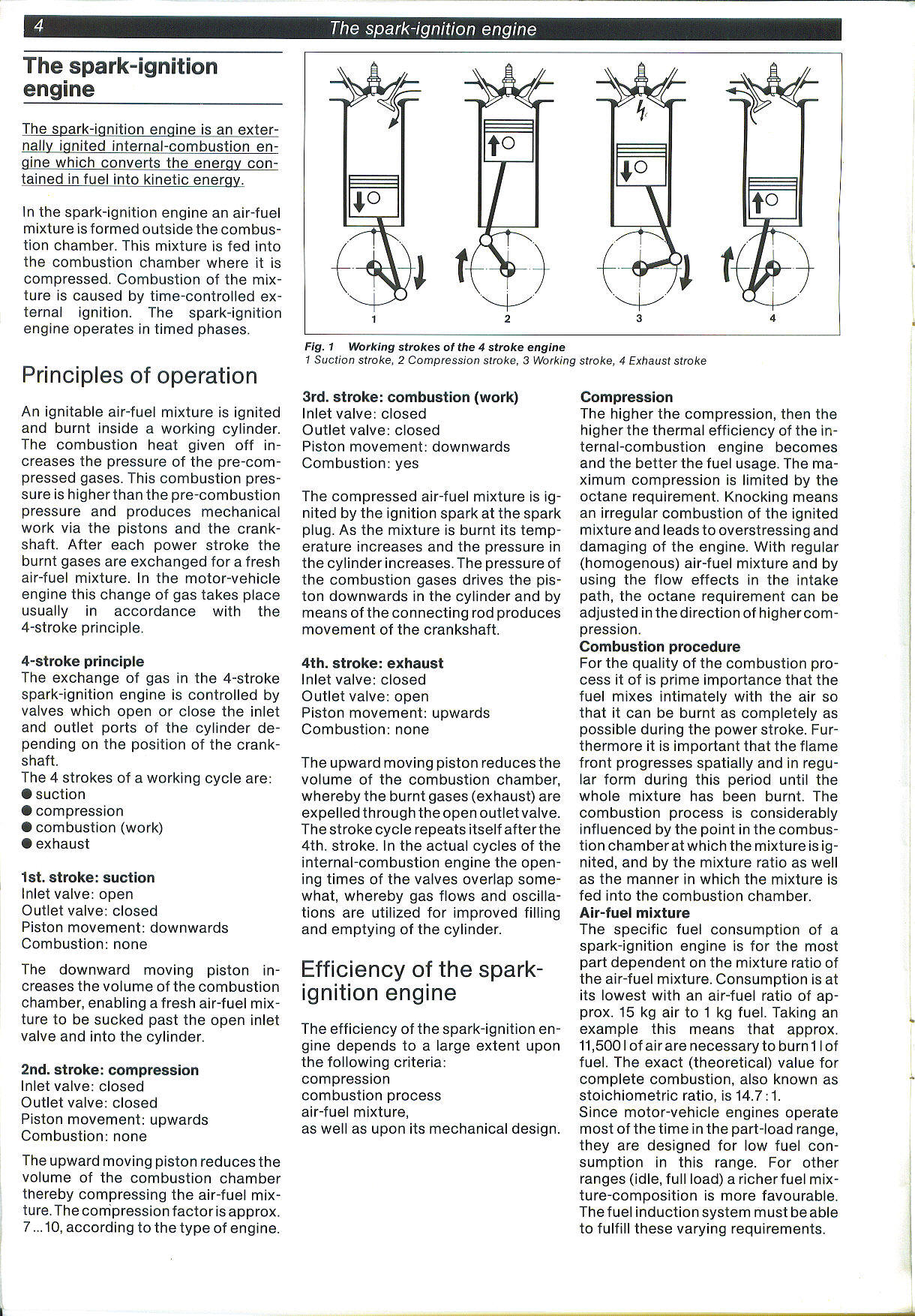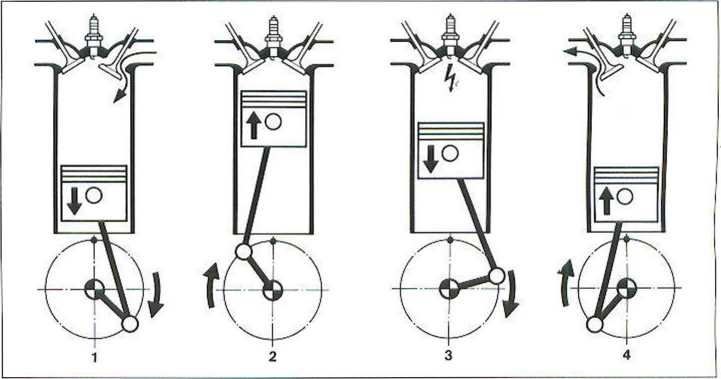Page04


Fig. 1 Working strokes of the 4 stroke engine
1 Suction stroke, 2 Compression stroke, 3 Working stroke, 4 Exhaust stroke
The spark-ignition engine
The spark-ignition engine is an exter-naJJy ignited internal-combustion en-gine which conyerts the energy con-tained in fuel into kinetic energy.
In the spark-ignition engine an air-fuel mixture is formed outside the combustion chamber. This mixture is fed into the combustion chamber where it is compressed. Combustion of the mix-ture is caused by time-controlled ex-ternal ignition. The spark-ignition engine operates in timed phases.
Principles of operation
An ignitable air-fuel mixture is ignited and burnt inside a working cylinder. The combustion heat given off in-creases the pressure of the pre-com-pressed gases. This combustion pressure is higher than the pre-combustion pressure and produces mechanical work via the pistons and the crank-shaft. After each power stroke the burnt gases are exchanged for a fresh air-fuel mixture. In the motor-vehicle engine this change of gas takes place usually in accordance with the 4-stroke principle.
4-stroke principle
The exchange of gas in the 4-stroke spark-ignition engine is controlled by valves which open or close the inlet and outlet ports of the cylinder de-pending on the position of the crank-shaft.
The 4 strokes of a working cycle are:
• suction
• compression
• combustion (work)
• exhaust
1st. stroke: suction
Inlet valve: open Outlet valve: closed Piston movement: downwards Combustion: nonę
The downward moving piston in-creases the volume of the combustion chamber, enabling a fresh air-fuel mix-ture to be sucked past the open inlet valve and into the cylinder.
2nd. stroke: compression
Inlet valve: closed Outlet valve: closed Piston movement: upwards Combustion: nonę
The upward moving piston reduces the volume of the combustion chamber thereby compressing the air-fuel mix-ture. The compression factorisapprox. 7... 10, according to the type of engine.
The spark-ignition engine
3rd. stroke: combustion (work)
Inlet valve: closed Outlet valve: closed Piston movement: downwards Combustion: yes
The compressed air-fuel mixture is ignited by the ignition spark at the spark pług. As the mixture is burnt its temperaturę increases and the pressure in the cylinder increases. The pressure of the combustion gases drives the piston downwards in the cylinder and by means of the connecting rod produces movement of the crankshaft.
4th. stroke: exhaust
Inlet valve: closed Outlet valve: open Piston movement: upwards Combustion: nonę
The upward moving piston reduces the volume of the combustion chamber, whereby the burnt gases (exhaust) are expelledthrough the open outlet valve. The stroke cycle repeats itself after the 4th. stroke. In the actual cycles of the internal-combustion engine the open-ing times of the valves overlap some-what, whereby gas flows and oscilla-tions are utilized for improved filling and emptying of the cylinder.
Efficiency of the spark-ignition engine
The efficiency of the spark-ignition engine depends to a large extent upon the following criteria: compression combustion process air-fuel mixture,
as well as upon its mechanical design.
Compression
The higher the compression, then the higher the thermal efficiency of the internal-combustion engine becomes and the better the fuel usage. The ma-ximum compression is limited by the octane requirement. Knocking means an irregular combustion of the ignited mixture and leads to overstressing and damaging of the engine. With regular (homogenous) air-fuel mixture and by using the flow effects in the intake path, the octane requirement can be adjusted in the directionof higher compression.
Combustion procedurę
For the quality of the combustion process it of is prime importance that the fuel mixes intimately with the air so that it can be burnt as completely as possible during the power stroke. Fur-thermore it is important that the flame front progresses spatially and in regular form during this period until the whole mixture has been burnt. The combustion process is considerably infiuenced by the point in the combustion chamber at which the mixture is ignited, and by the mixture ratio as well as the manner in which the mixture is fed into the combustion chamber. Air-fuel mixture
The specific fuel consumption of a spark-ignition engine is for the most part dependent on the mixture ratio of the air-fuel mixture. Consumption is at its lowest with an air-fuel ratio of ap-prox. 15 kg air to 1 kg fuel. Taking an example this means that approx. 11,5001 of air are necessary to bum 11 of fuel. The exact (theoretical) value for complete combustion, also known as stoichiometric ratio, is 14.7:1.
Since motor-vehicle engines operate most of the time in the part-load rangę, they are designed for Iow fuel consumption in this rangę. For other ranges (idie, fuli load) a richerfuel mix-ture-composition is morę favourable. The fuel induction system must beable to fulfill these varying requirements.
Wyszukiwarka
Podobne podstrony:
image038 a Fig 10 Idea of the “World tree" as the “World axis" implemented m settlements o
Slajd66 Bielactwo - leczenie- terapia łączona_ Fig. 3.8.1 (a) Vitiljgo patehes of the face. (b) Glin
6 L. Starkel Fig. I. Ideał model of the organization of research in the national project MR 1 — 25 “
Fig 3. Superior view of the sellar region and its related bonę struć-tures. The arrow indicates the
Fig. 6 - Back analysis of the "Cannicella" landslide Fig. 5 - Scarp of the "Cannicell
Fig. 3 - Panoramie view of the Southern side of Orvieto Hill. The following can be noted in the
44393 system 38 38 And a captain of the Royal Engineers. India, wbo reduced his weight in eighteen m
45144 tmta 2 Gorget - See Men s hoods, Fig 6. Grain - Direction of the warp threads on a woven fabri
CCF20100223�005 Fig. 21. Englńti [u:), lougue poation Fig. 2Z Position of the lips
CCF20100223�008 3y6: ■ Lnng central e, Le. (a:] Fig. 28. Poation of the lips Fig. 27. English (»:),
18648 Slajd66 Bielactwo - leczenie- terapia łączona_ Fig. 3.8.1 (a) Vitiljgo patehes of the face. (b
P1120510 resize « - rrmtc 2fi8 Kv.c 13^ Of61ny widok stosu, ns którym ■ Fig.
DSC07056 Ryc. 266. Koncepcja rozwoju miejscowości z propozycją ścieżek tematycznych (2003) Fig. 266.
więcej podobnych podstron